Krakow 2017-08-20
269 Section 1984-05-05
OKB Suchoj Su-22 UM 3 K
The two-seat combat aircraft.
History
Su-22 in Poland
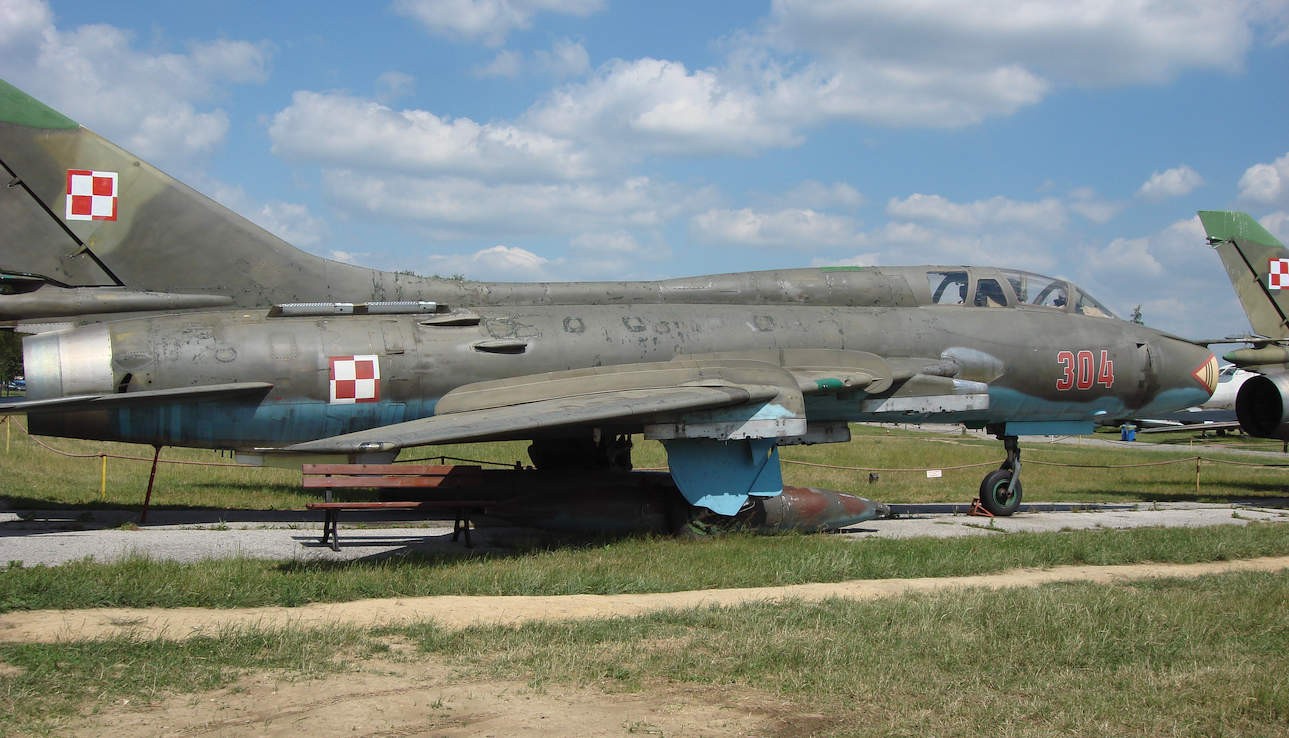
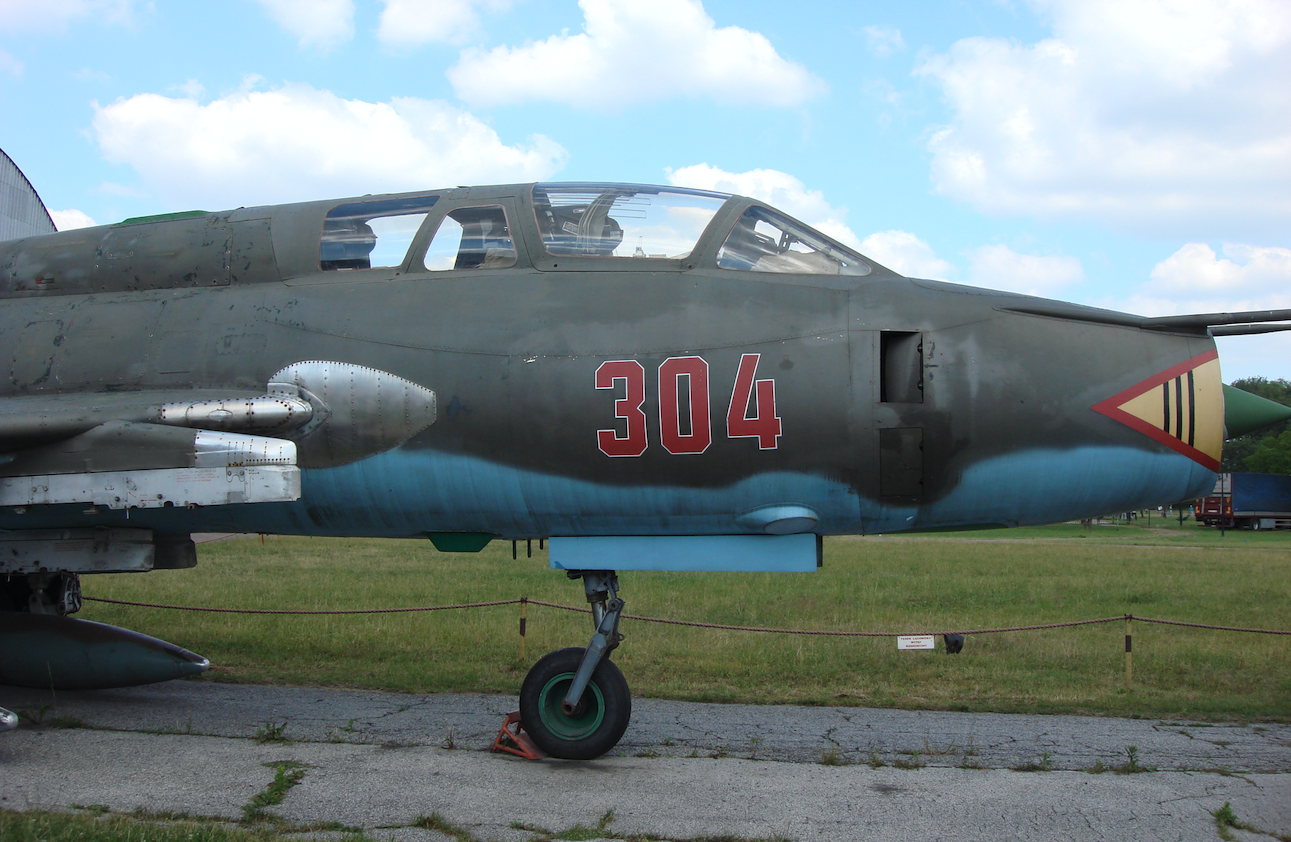
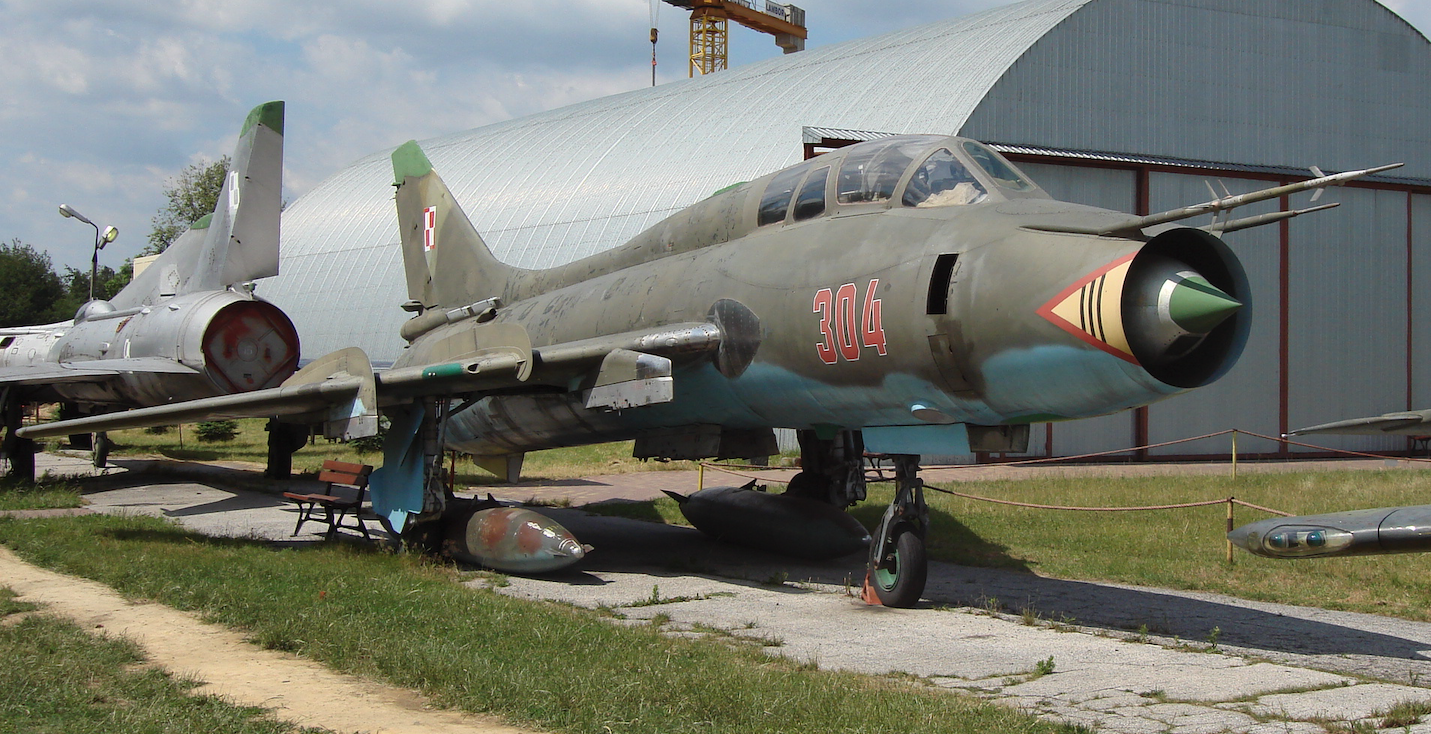
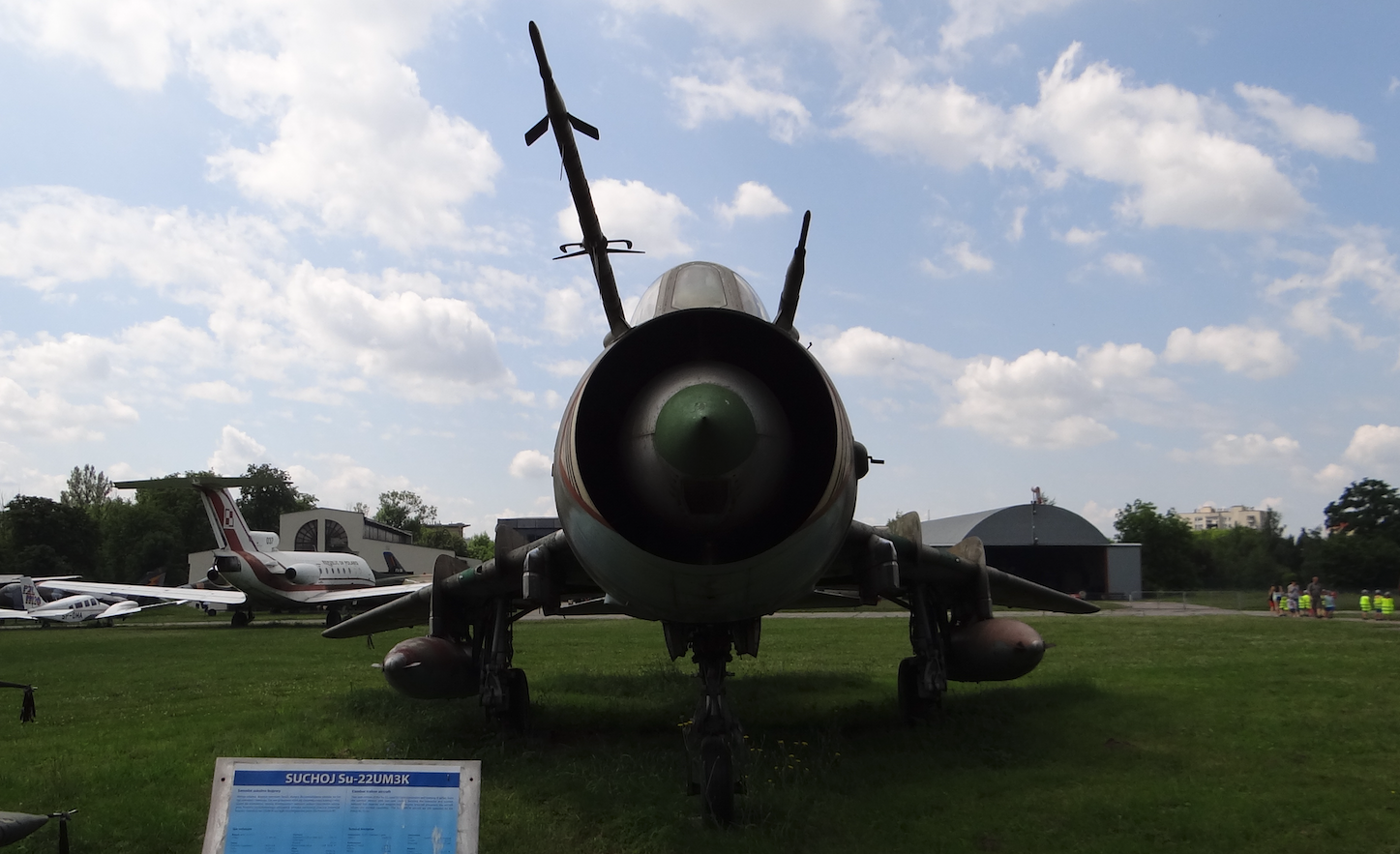
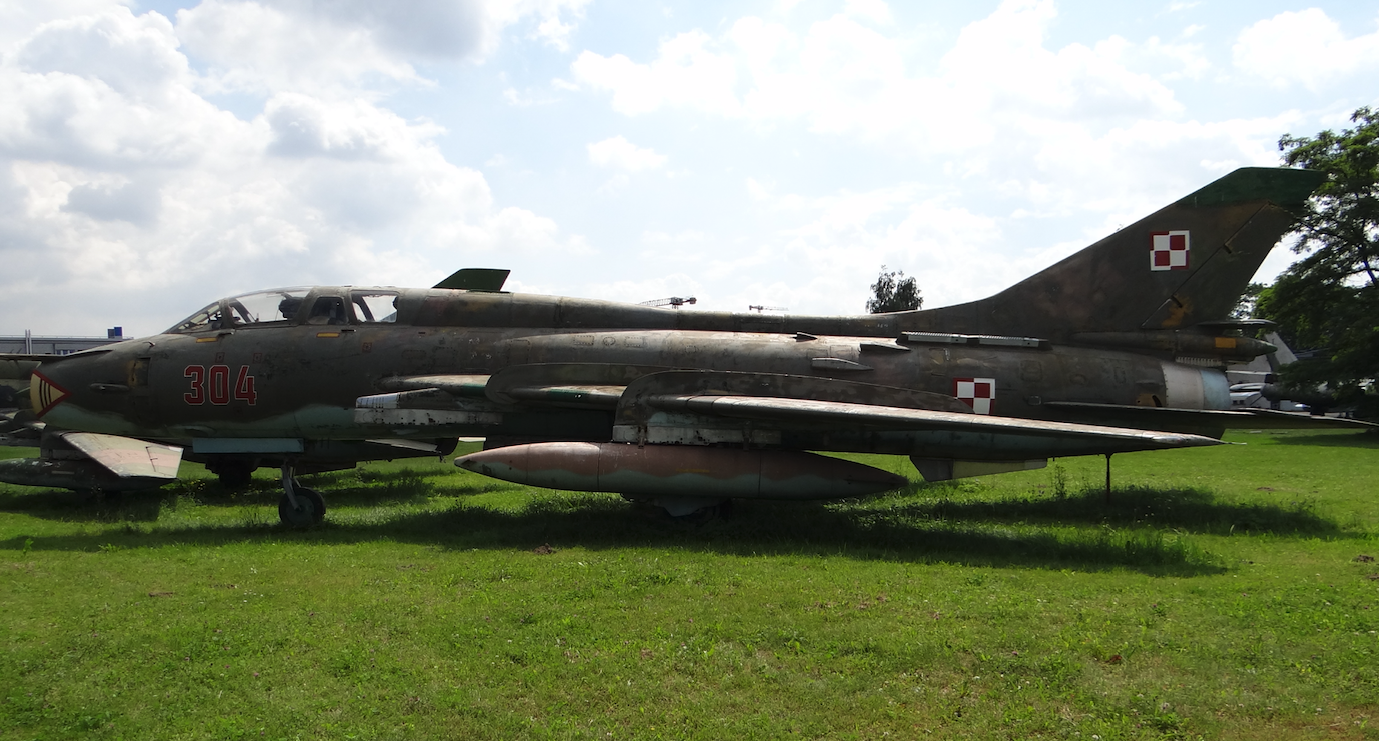

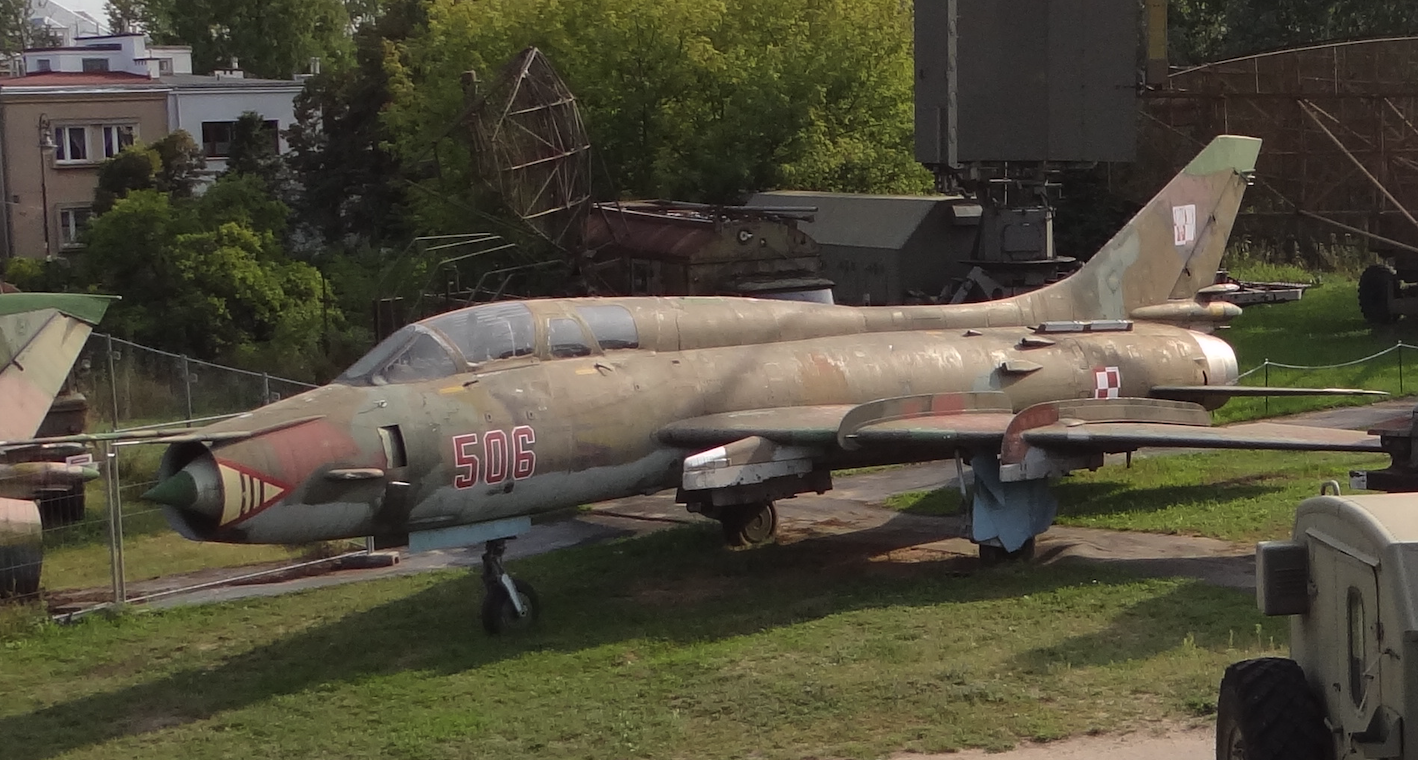
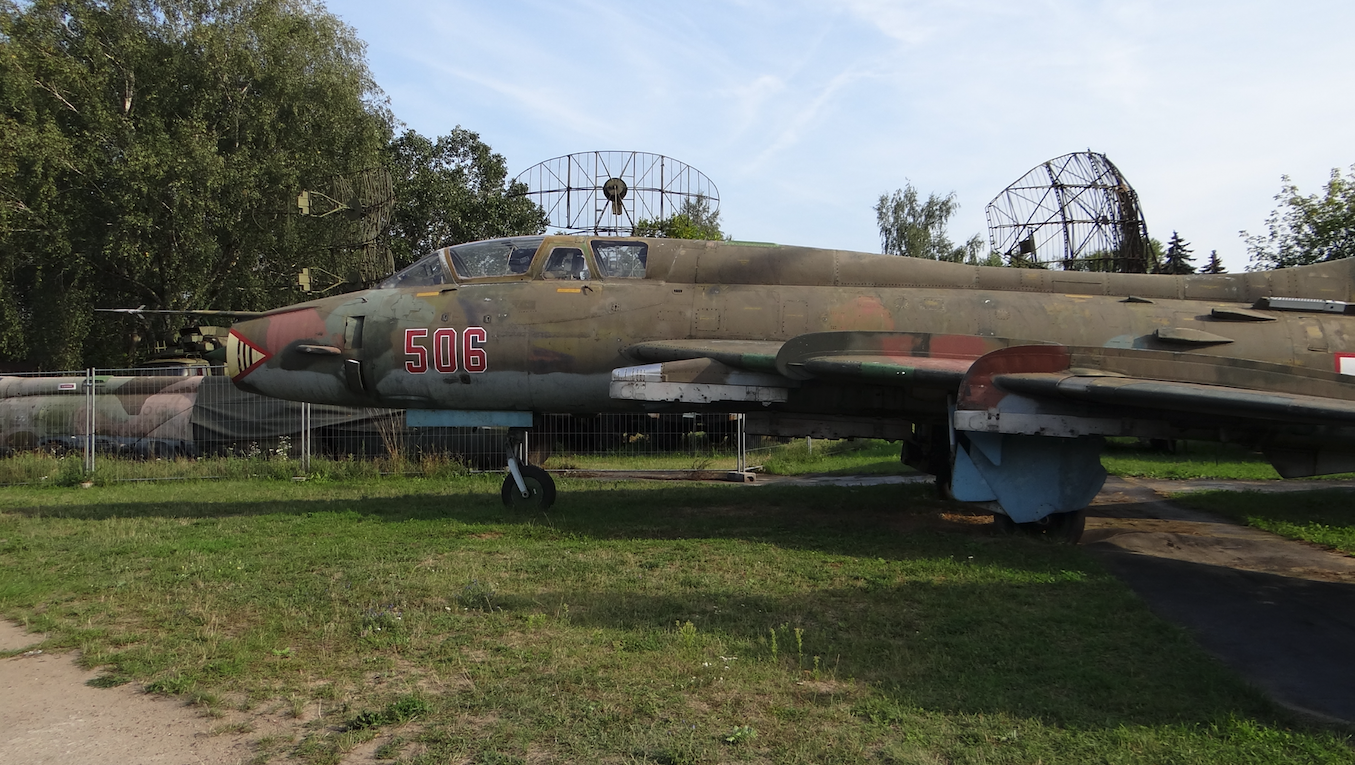
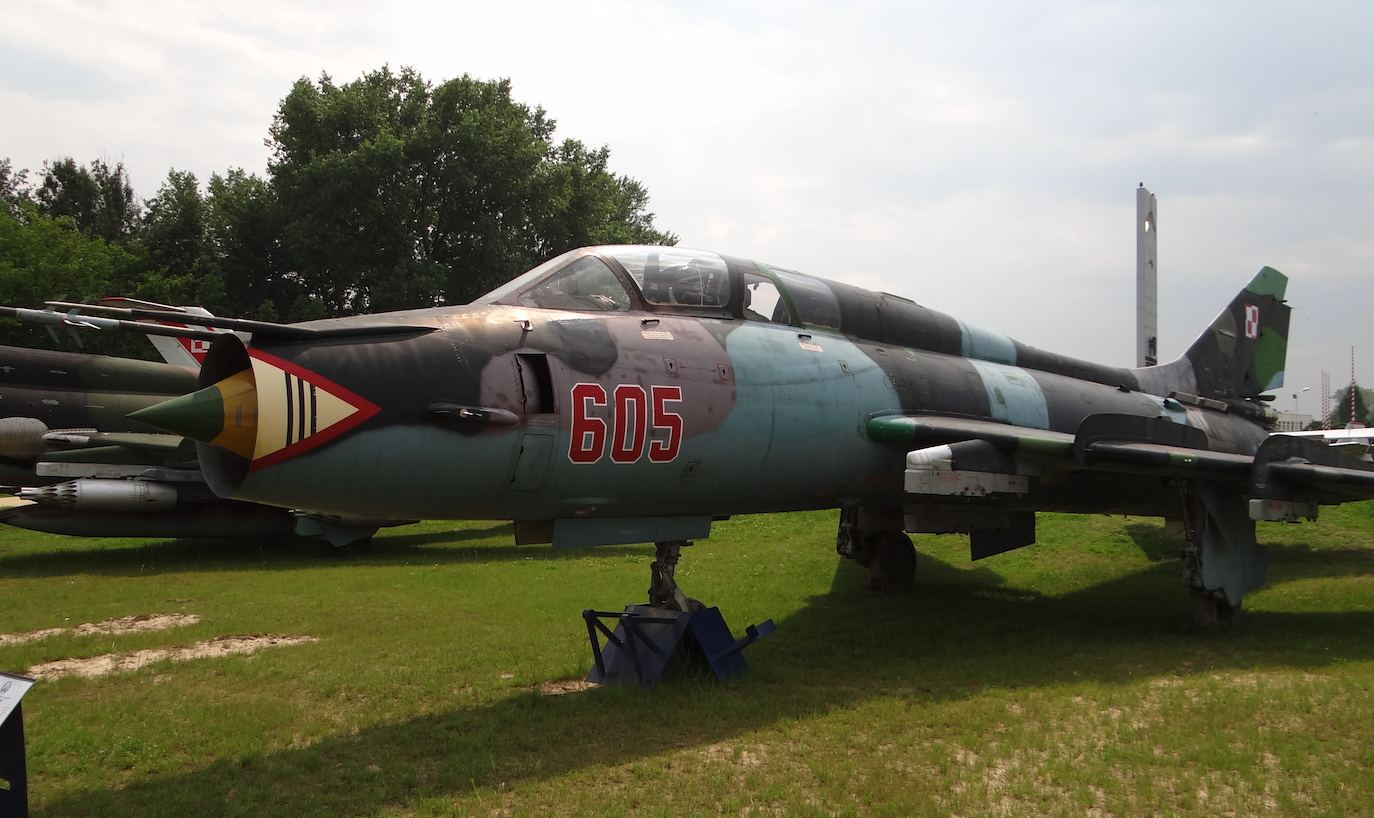
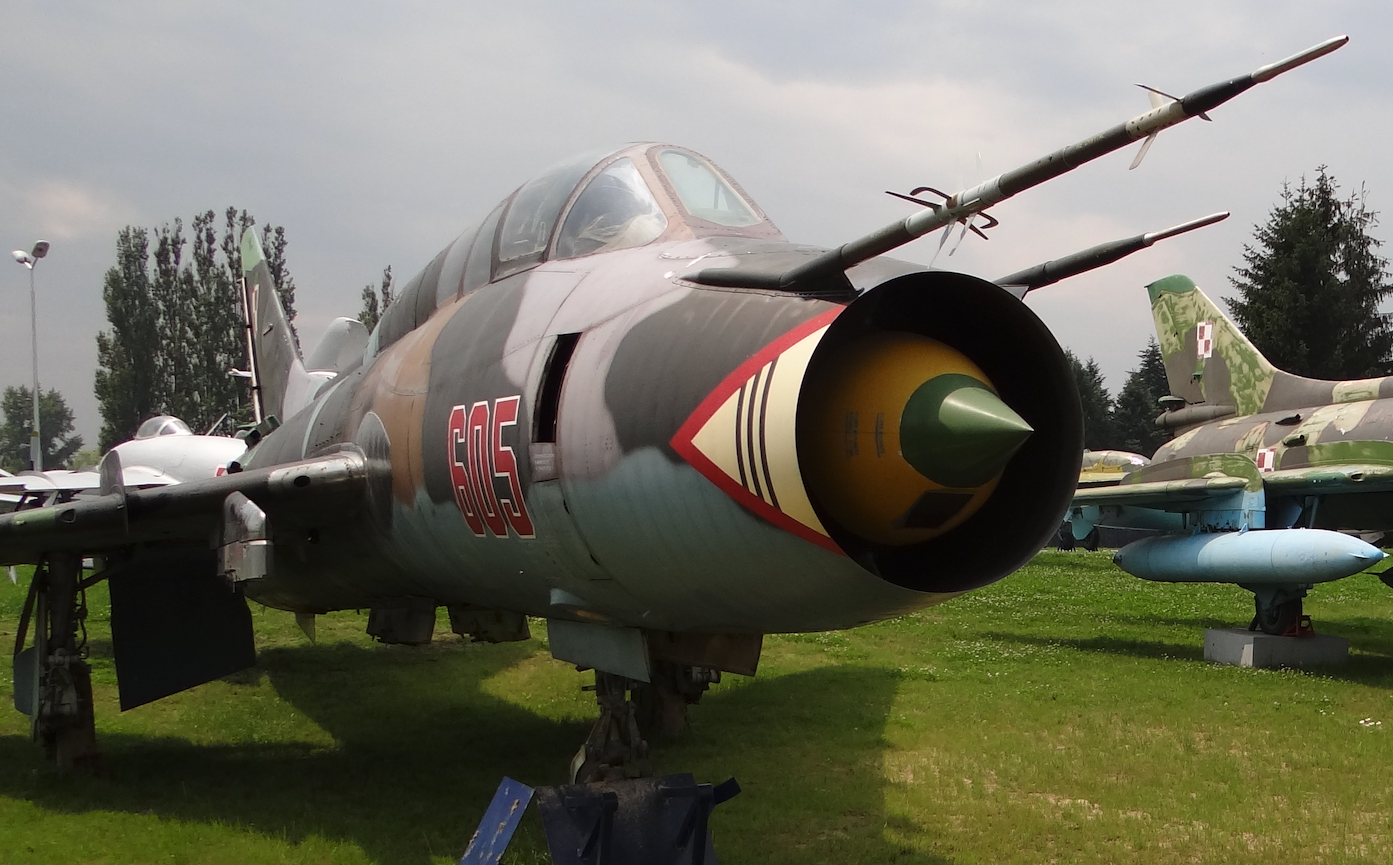

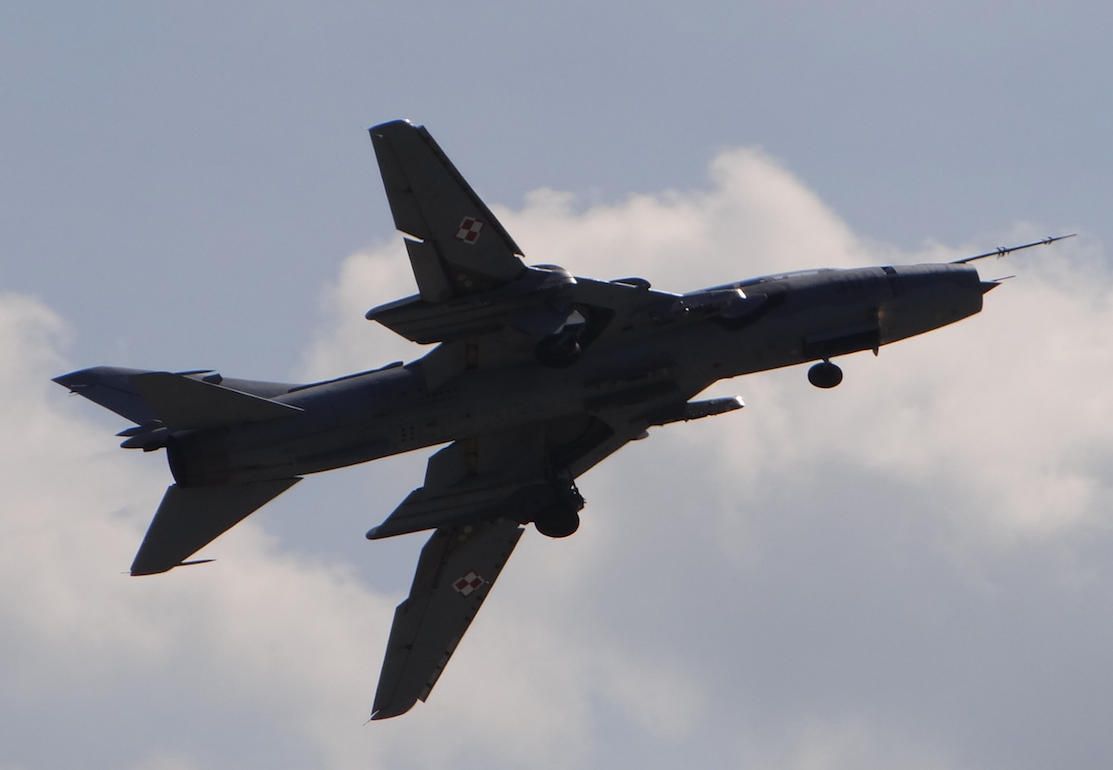
History
In CCCP, the Su-17 plane, despite constant modifications and the creation of its second generation, still did not meet the assumptions made. It was not about volatile properties and performance, but about the possibility of effectively attacking ground targets in "all weather conditions". The variable geometry of the wings was not a sufficient argument here. The key to success was new equipment based on modern electronics, and the one at CCCP was not there. Building highly specialized aircraft did not help solve the problem.
On the Su-17 M 2 fighter-bomber plane, the assembly of the target electronics and weapons was planned. The pilot’s working conditions have been improved by expanding the cabin. However, the front of the hull limited visibility. In addition, there was no training and combat aircraft on which it was possible to safely train new pilots. The Su-7 U did not perform this task well anymore. In October 1974, the Soviet authorities ordered OKB Suchoj to build two new Su-17 varieties:
- S-52 – The pilot is to have better visibility from the cabin. On the plane the electronics were supposed to be a kompatibile with electronics from MiG-27 M.
- S-52 U – A training and combat plane. This version was supposed to be created first.
Su-17 UM 3 (S-52 U). 1975
The S-52 aircraft received a rebuilt front part of the hull. The pilot’s cabin was raised higher, which improved the visibility. But. No two major changes were made; The use of radar, which would significantly improve the combat capabilities of the aircraft. Second change. The aircraft did not receive side air intakes to the engine, as was done with MiG-21 – MiG-23 machines.
Based on the S-52 aircraft, a training-combat variant S-52 U (S-53) was built. Aviators’ seats were placed in tandem. A centralized catapulting system with K-36 D S 2 armchairs was introduced. The instructor’s cabin was equipped with a periscope system. The place for the second seat was obtained at the expense of reducing the fuel tank No. 1. In general, the fuel supply decreased to 3 050 kg. Electronic equipment has been modified by introducing the SAU-22 MU control system. SPU-9 on-board conversation and MS-61 tape recorder added. The left machine gun was dismantled, but the mass of the aircraft increased to 10,900 kg. The lifting capacity of the weaponry has decreased to 3,000 kg.
The first prototype of the S-52 U aircraft made its first flight in September 1975. During state tests in 1976, S-52 U was recommended for mass production under the designation Su-17 U. The trials were completed in May 1977. From 1978, Su-17 UM (S-52 UW) was built with elevated vertical stabilizer and aerodynamic steering wheel under the fuselage. Gradually (1979-1980) all aircraft were brought to this standard.
In July 1978, a decision was made to build a training and combat aircraft with avionics from Su-17 M 3. In October 1978 the first flight was made S-52 UM 3, but his research lasted two years and the plane went on trial in May 1981. The serial production of this aircraft lasted from 1978 to 1979 and closed with 165 machines. Importantly, all 75 previously produced Su-17 UM planes were delivered in the years 1981-1983 to the Su-17 UM 3 standard. In summary, 240 Su-17 UM 3 machines were built in total.
The Su-22, Su-22 M and Su-22 M 3 combat aircraft variants with the R-29 BS-300 engine were respectively designated Su-22 U, Su-22 UM and Su-22 UM 3. Prototype Su-22 22 U came from the modification of one of the first Su-17 U. It was built in October 1976 and flown in December 1976. In April 1977, factory tests were completed and the machine was sent to state trials. They lasted from September 1977 to March 1978 and then the aircraft was sent to series production. The Su-22 UM prototype was flown in December 1979. The production was carried out in 1979-1984, when 45 machines were built. In the years 1982-1983, 9 Su-22 UM 3 machines were produced.
In 1983, the decision was made to export the newest versions of Su-17 M 4 and Su-17 UM 3 for export. They obtained Su-22 M 4 (S-54 K) and Su-22 UM 3 K (S-52 M, respectively) 3 K). They were equipped with AL-21 F-3 engines, small changes were made in electronics, and in addition to TV-controlled rockets, the entire remaining range was offered. In total, until 1990, 347 Su-22 M 4 and 60 Su-22 UM 3 K aircraft were produced. It is also estimated that the total production of Su-17 aircraft was 2,864 machines.
The history of the purchase of Su-22 M 4 K and Su-22 UM 3 K aircraft for the Polish Army.
The outbreak of the Second Cold War in the early 1980s forced the rearming of the Warsaw Pact countries. In Poland, aircraft MiG-23 MF and MiG-21 bis were introduced to the armament of the fighter air force. However, the real changeover took place in the fighter-bomber (assault) aviation, in terms of quality and quantity. Poland bought Su-22 planes in two versions; single-seater Su-22 M 4 K and two-seater Su-22 UM 3 K. In 1985, the first 20 (one-seater) and six (two-seater) were delivered. In total, we bought 90 one-seater and 20 two-seater.
In the period August-October 1984, the first 13 aircraft reached the Powidza on the Il-76 and An-12/22 decks. It was 7 Su-22 M 4 machines (nb 3005, 3212, 3213, 3908, 3909, 3910, 3911) and 6 military-training Su-22 UM 3 K (104, 305, 306, 307, 308, 509). All planes became part of the 6th PLM-B (regiment of fighter-bomber aviation) in Piła. In August 1985, his first Su-22 received 40 PLM-B from Świdwin, and in May 1986, the third squadron of the 7th PLB-R (regiment of bomber-reconnaissance aviation) with Powidza (initially this squadron was to be included in the 8th PLM-B in Mirosławiec). Individual copies were sent to Oleśnica for some time to train aircraft maintenance.
In May 1985, the first group of pilots went to Krasnodar to train for new equipment. They returned in July 1985.
Deliveries Su-22 were carried out differently than 10 years earlier Su-20, which just flew. Su-22 was delivered to Powidz in boxes. Here, the Soviets assembled and ran the equipment themselves. Only then did they transfer to the Polish side. Probably the first Polish Su-22 M 4 soviets in Powidz were on May 5, 1984. Technical life of the Polish Su-22 during the period of peace is 20-25 years. However, as it turned out, the plane is relatively easy to renovate and can be used for over 40 years.
The first unit equipped with new aircraft became the 7th PLMB with Powidza. Next is the 6th PLMB in Piła and 8 PLMB in Mirosławiec. Each of the units received 36 machines for 3 squadrons.
The first period of use of new machines fell on the second half of the 80’s. Polish pilots quickly mastered the pilot and in the first years of operation they performed takeoffs and landings at roadside sections of the airport (DOL). Combat training was carried out on the Nadarzyce training ground and on the marine training ground near Ustka. Training with the use of new guided weapon – missiles was particularly important.
As of 1 January 1991, we had 85 Su-22 M 4 K and 19 Su-22 UM 3 K on weapons. We lost 2 pilots and 3 Su-22 M 4 K and 1 Su-22 UM 3 K. W During the 90th years Polish Air Force received new tasks. To do them effectively, it was necessary to regroup forces. The result was the liquidation of the Su-22 aircraft base in Piła and its transfer to Świdnica. Thanks to this Su-22 planes were more evenly distributed, although the ideal was far away. For example, it was not decided to ferry the Su-22 aircraft to a large base in Biała Podlaska, in the east of Poland.
Poland’s accession to NATO (1999-03-12) affected the new division of air divisions. The regiments disappeared, and the squadron became the basic organizational unit. Each squadron with 16 aircraft. According to the agreements, Poland should have ten tactical aviation squadrons (ELT), or about 160 combat aircraft.
After Poland’s accession to NATO, Su-22 aircraft were adapted to operate in their structures. First, the radio panel was replaced so that the communication mode used in NATO could be used. The next stage was to mention navigation equipment. However, it should be remembered that the Polish Su-22 has never been adapted to operate outside our country. It was already anticipated that it would be in operation until around 2015.
On 2000-01-01, we had 80 Su-22 M 4 K and 18 Su-22 UM 3 K, respectively, on the armaments, and were a significant force. In the 90’s, we lost 4 pilots and 5 single-seater machines and 1 two-seater. In 2000, airplanes were grouped in 5 squadrons; in Świdwin, Mirosławiec and Powidz. In each squadron about 20 machines were collected. Poland has a full technical base for carrying out repairs. The engines are being renovated in Warsaw. Airplanes in Bydgoszcz. By 2007, we lost a total of 8 pilots and 12 machines, including two two-seater. In 2007, a decision was made to terminate exploitation in 2011-2012, ie until the technical resources were exhausted. According to the "Armed Forces Development Plan for the years 2005-2010" in 2008, we will be operating 48 Su-22 aircraft constituting the armament of three tactical aviation squadrons. Around 2010, all Su-22 aircraft remaining on the armaments (about 40 pieces) were gathered in one base in Świdwin. Not all planes were kept at full combat disposal, because they were limited to one squadron of tactical aviation.
In 2012, the purchase of 16 F-16 aircraft used from USAF stockpiles was discussed. However, the then Government of the Republic did not decide to take such a step, claiming that General Dynamics F-16 C planes are completely different machines than the Lockheed F-16 Hawk. Therefore, in 2014, a decision was made to renovate and retrofit 12 pieces of Su-22 M 4 and 6 training-combat Su-22 UM 3 K. On February 9, 2015, an agreement was concluded between the 3rd Regional Logistics Base ( Aviation Technology Department Kutno), and Wojskowe Zakłady Lotnicze No. 2 in Bydgoszcz. The contract price is about 8.9 million PLN per piece and about 160 million PLN for the whole work. In 2015, four Su-22 M 4 aircraft were refurbished (nb 7816, 8101, 8205, 8309) and two Su-22 UM 3 K (nb 308, 509). In 2016, another four Su-22 M 4 and two Su-22 UM 3 K, and in 2017 another four Su-22 M 4 and two Su-22 UM 3 K. Repair of aircraft was combined with the refurbishment of AL-21F3 engines, which they were renovated in WZL No. 4 in Warsaw.
The planes for refurbishment were arriving on their own. Renovation of aircraft extended their use for another 10 years or 800 flight hours or 1,200 landings. Sparki have an increased number of landings up to 1,600 operations. During repairs, not only the worn components were replaced, but also those whose life was no longer long. The overhauls of beams, beams, launchers, additional tanks and airport equipment were also carried out. In the aircraft, the RS-6113 communication radio station received the range of 8.33 kHz. In the dashboard, pilot instruments for instruments with Anglo-Saxon measures are listed. The Su-22 UM 3 K version has a load monitoring system to catch hard landings.
Renovated planes received new painting. The painting was called NAVY, sea shades of gray, and more colloquially "dove camouflage". The aim was to unify the color of Polish combat aircraft (F-16, MiG-29) and transport aircraft (C-295). Painting was necessary because the average coating on a commercial aircraft lasts about eight years. Bydgoszcz has a modern painting and painting set AERODUR-5000 from AKZO Nobel. After washing the old varnish coat, the first adhesive layer is applied, then the primer and topcoat. The renovation of one aircraft lasted from 8 to 9 months.
List of modernized aircraft:
Su-22 UM 3 K nb 308, 310, 508, 509, 706, 707.
Su-22 M 4 K nb 8205 (modernized first), 3201, 3304, 3612, 3706, 3713, 3715, 3920, 7410, 8101, 8309, 8920.
Written by Karol Placha Hetman
Krakow 2017-08-20
Su-22 UM 3 K
269 Section 1984-05-05
A two-seat combat aircraft.
Construction
Su-22 in Poland
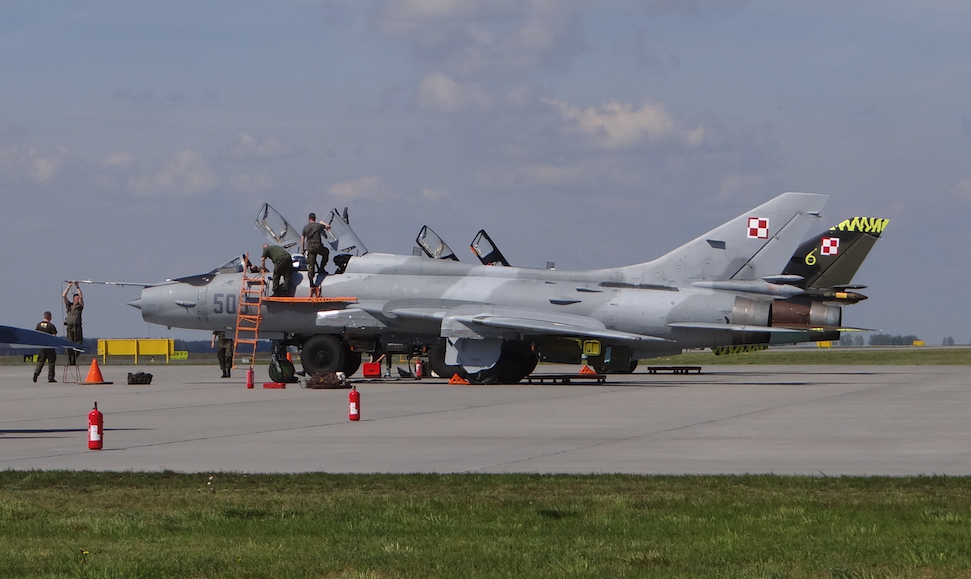
A two-seater, single-engine fighter-bomber plane. Built in a classic layout with a variable geometry wing. The fuselage is made of aluminum and titanium alloys.

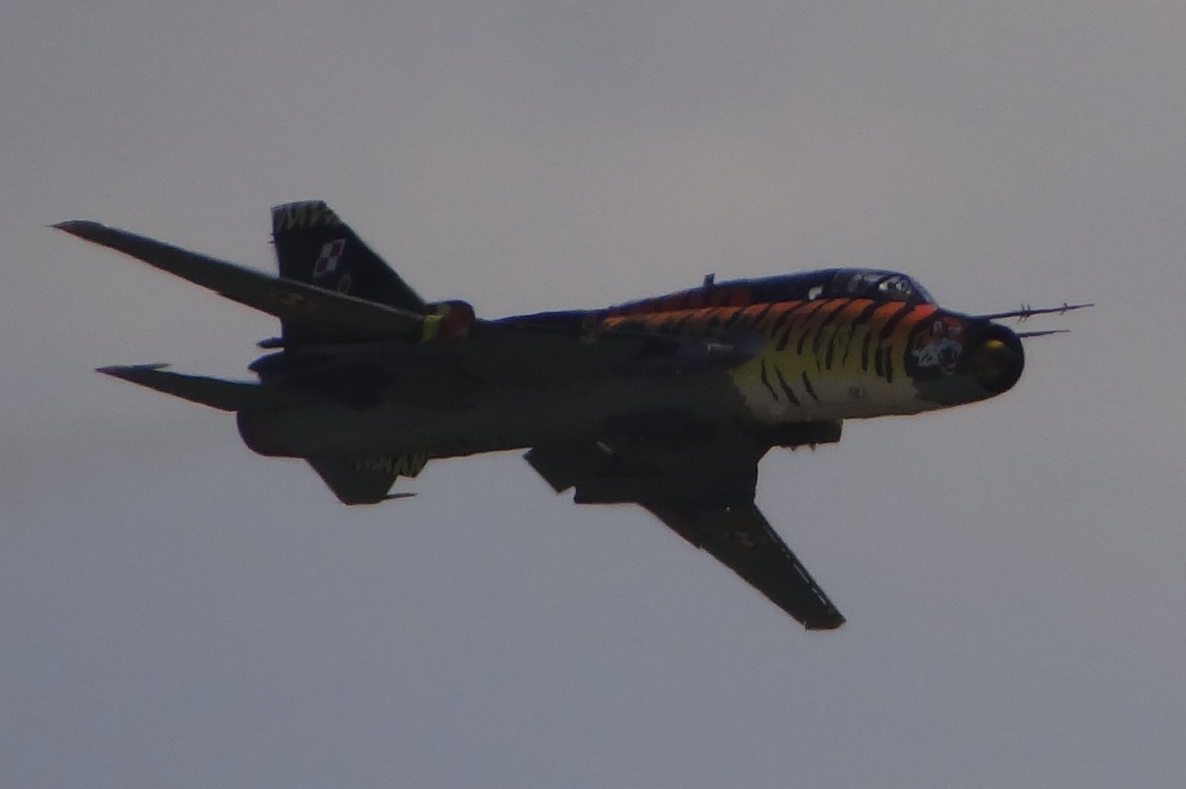
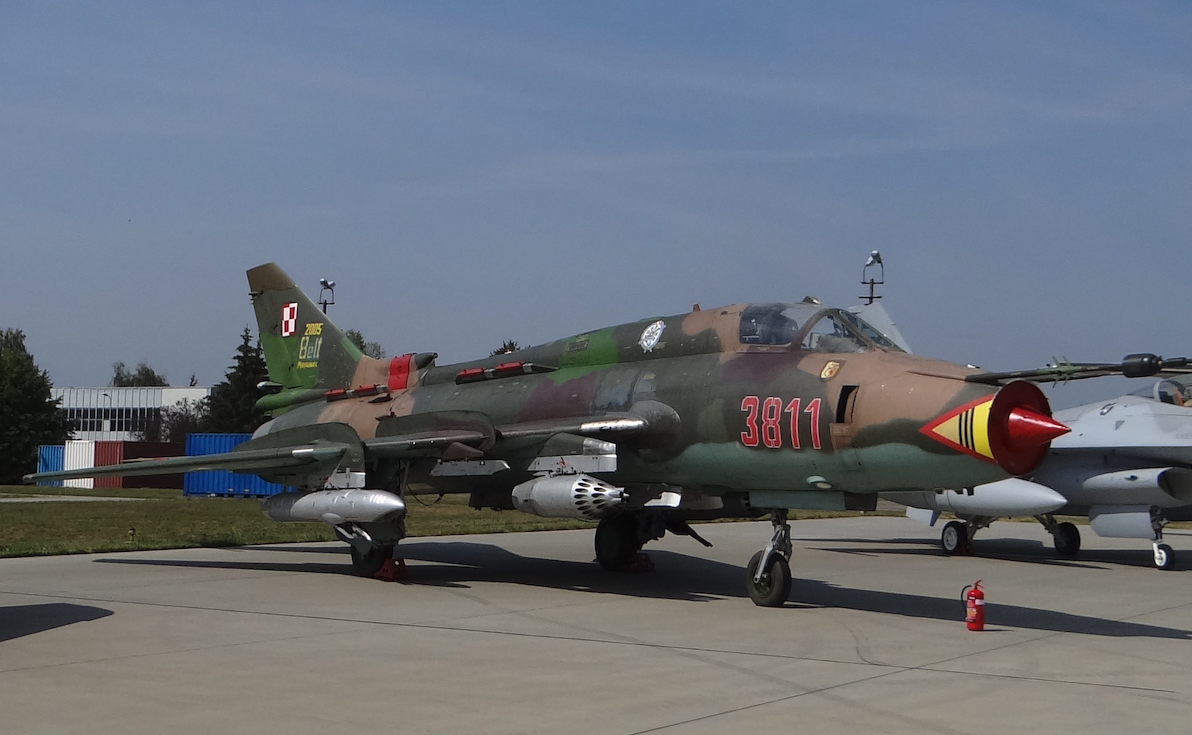
The wings consist of a fixed part and external moving parts, 4 m long, taking two positions. The minimum skew angle is 30 degrees. The maximum 63 degrees. It is also the angle of skew of the fixed part of the wings. One and the other part are hinged together. At the front with a large bearing pin, which is the axis of rotation. On the back of the support is a four-wheeled trolley moving on guides mounted inside the stationary part. The movement is carried out by a hydraulic system. Fixed parts were equipped with two sections of slotted flaps on the canoe. The outer parts received ailerons and slit flaps on the path. On the leading edge there are three-sectional gills (slots). The wing received two pairs of high aerodynamic blades and three pairs of smaller aerodynamic blades that strengthen the construction of fixed wing parts. Covering of the wings was made by chemical etching. Steering surfaces were made of 3-ply glued boards with a honeycomb filler.
The fuselage with a half-shell structure and a section similar to a circular one. The maximum diameter is 1.75 m and the length of the hull is 15.572 m. The frame fuselage to No. 13 is tilted down by 3 feet. It is technologically divided into two parts. The division takes place at the number 34 frame. The removable rear part of the fuselage allows access to the engine. Front air grip with central intake cone that can take two positions. The cabin is hermetic and air-conditioned. It provides excellent working conditions and good visibility. The cabin was placed between frame number 4 and 9. Throw-out seat K-36 class 0-0. It allows you to safely leave the aircraft in the speed range from 0 km / h to 1 300 km / h, at any altitude. The cover opens upwards to the rear. A periscope was placed on the windshield to observe the rear half-zone. Four aerodynamic brakes are located in the rear of the fuselage.
The tail. Horizontal plate with 55 degrees angle on 25% chord. Mounted with a negative 3-degree lift. At the ends, anti-flutter masses were mounted. The shift is from +25 degrees 30 minutes to -10 degrees. The vertical elevation is divided into a rudder and a ballast. The skew is 55 degrees.
The aircraft has a three-points chassis with oil-pneumatic shock absorbers and hydraulic brakes. The front wheel, 660 x 200 mm, is pulled forward into the chamber under the cab floor. Main chassis with single wheels, size 880 x 230 mm. The base of the chassis is 5.24 m, the main chassis spacing is 3.85 m.
Differences between one-seater and two-seater aircraft.
The plane has a double cabin. Aviators’ seats were placed in tandem. A centralized catapulting system with K-36 DS 2 armchairs was introduced. The instructor’s cabin was equipped with a periscope system similar to that used in Su-7 U aircraft. The place for the second seat was obtained at the expense of reducing the fuel tank No. 1. In general, the fuel supply decreased to 3 050 kg, and thus range.
Aircraft equipment modified by introducing the SAU-22 MU control system. An SPU-9 on-board telephone and MS-61 tape recorder have been added. The left cannon was dismantled, but the weight of the aircraft increased to 10,900 kg anyway. The lifting capacity of the weaponry decreased to 3,000 kg and therefore the second pair of sub-fuselage nodes have been abandoned.
Su-22 powered
Su-22 airplanes, depending on the customer, are equipped with an AL.-21 or R-29 engine. All Polish Su-22 planes were equipped with AL-21 engines, the same ones that were powered by Su-20 planes. These engines are being renovated in Poland in Warsaw.
AL.-21 is the engine of A. Lulka AL.-21 F-3 of 1 x 76.50 kN, and with the afterburning 1 x 110.00 kN. This engine is special adapted for flights at low altitudes. It is a single-flow turbine composed of; 14-stage axial compressor, annular combustion chamber, 2-stage turbine and afterburner. The engine is cooled by air drawn by 4 grips placed on the fuselage at the rear.
Kerosene fuel T-1, TS-1, RT. IPM-10 or synthetic WNII-50 oil. Unit fuel consumption 0.9 – 1.2 kg / daN / h, with afterburning 1.5 – 2.0 kg / daN / h. The engine’s resure is 900 – 1500 hours depending on the production series. The period between repairs is 350 – 450 hours.
The fuel system consists of 4 tanks placed in the fuselage and two integral ones placed in the movable parts of the wings. In addition, the aircraft can carry 4 additional tanks (2 under the fuselage and 2 under the wings).
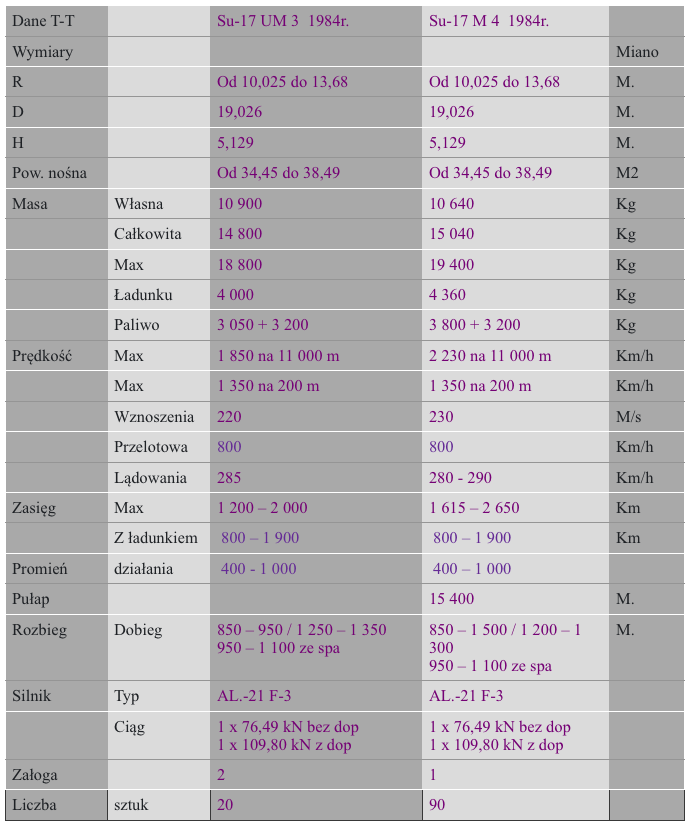
Written by Karol Placha Hetman
Krakow 2017-08-20
269 Section 1984-05-05
Su-22 UM 3 K
Two-seater combat aircraft
Tally
Su-22 in Poland
The tally of Su-22 aircraft used in Poland is contained in Section – Sukhoi Su-22. 1985. – Tally
Prepared by Karol Placha Hetman
